In progress …
Note: (a) A sutta whose title is preceded by an asterisk (*) means that it is only an excerpt. (b) All files are in pdf.
Celebrating 20 years (2002-2023) of full-time sutta translation and teaching by Piya Tan (TAN Beng Sin) assisted by Ratna Lim and family:
Handbook of Meditation in Society 1 + 2, 3, 4, 5.6 (SD 60.1ab, SD 60.1c, SD 60.1d, SD 60.1e, SD 60.1f) by Piya Tan: covers/imprints/detailed contents [download].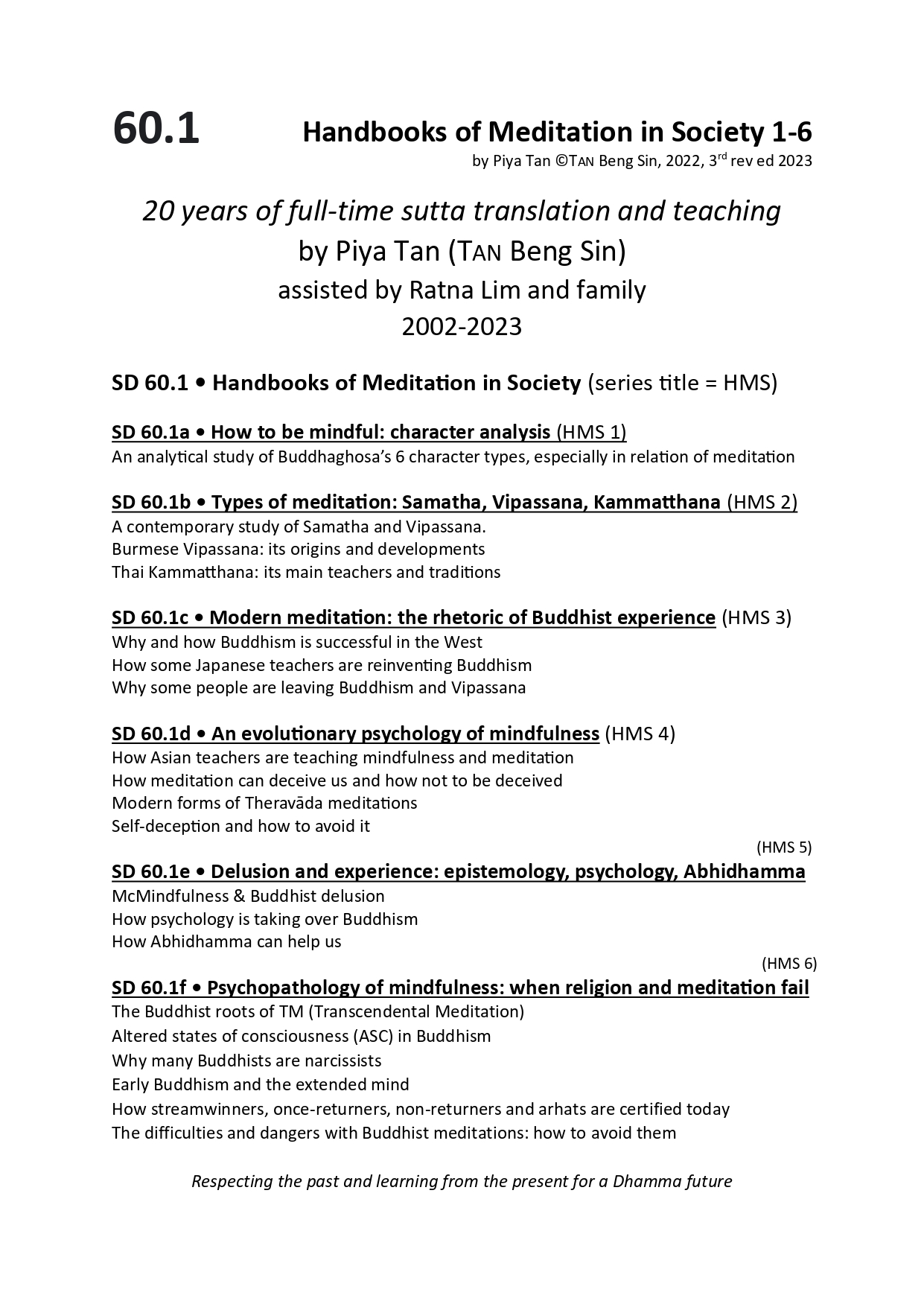

Handbook of Meditation in Society 1 & 2 by Piya TanSD 60.1ab: Character analysis; and Samatha, Vipassana, Kammatthana (2022a, 2023 rev) [ISBN 978–981–18–5504–7]“Meditation is the ground from which we rise into the space of freedom.” | |||
|---|---|---|---|
| SD No. | Sutta or Chapter Title | Sutta reference | Theme |
| 60.1ab | Character analysis; types of meditation: samatha, vipassana, kammatthana. | ||
| 60.1ab | SD 60.1ab Handbook of Meditation in Society 1 & 2 | ||
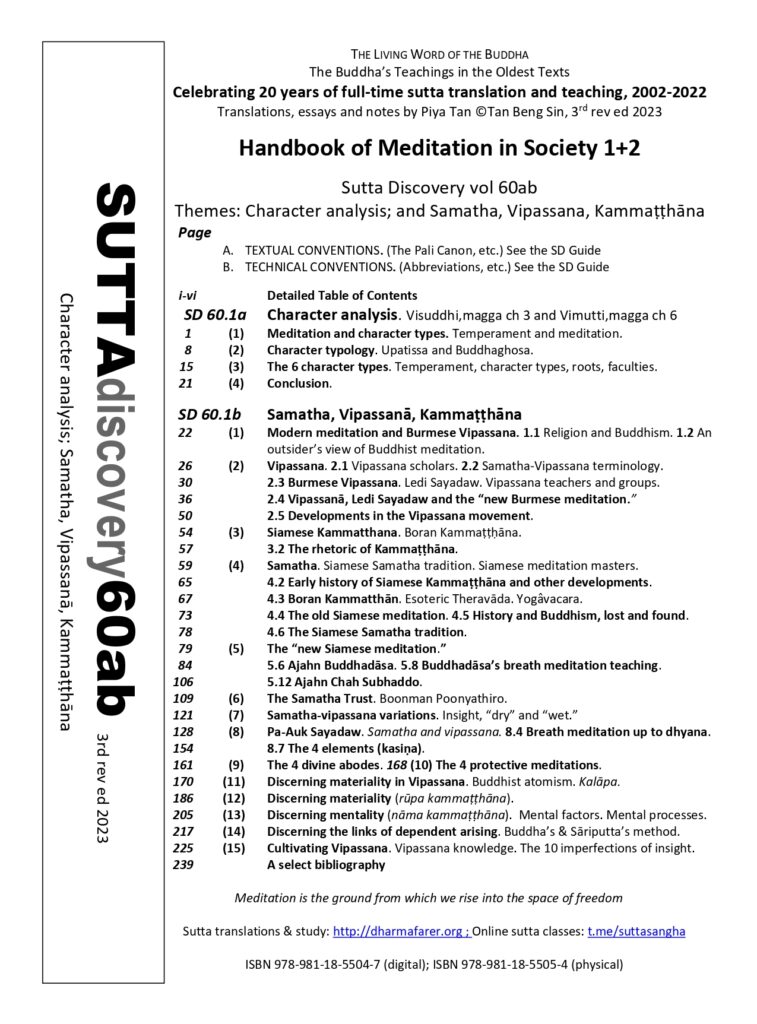
Note: (a) A sutta whose title is preceded by an asterisk (*) means that it is only an excerpt. (b) All files are in pdf.
Handbook of Meditation in Society 3 by Piya TanSD 60.1c: The rhetoric of Buddhist Experience: A psychosocial exploration of modern Buddhism (2022b).“Buddhism is daily experience fully and joyfully understood.” |
|---|
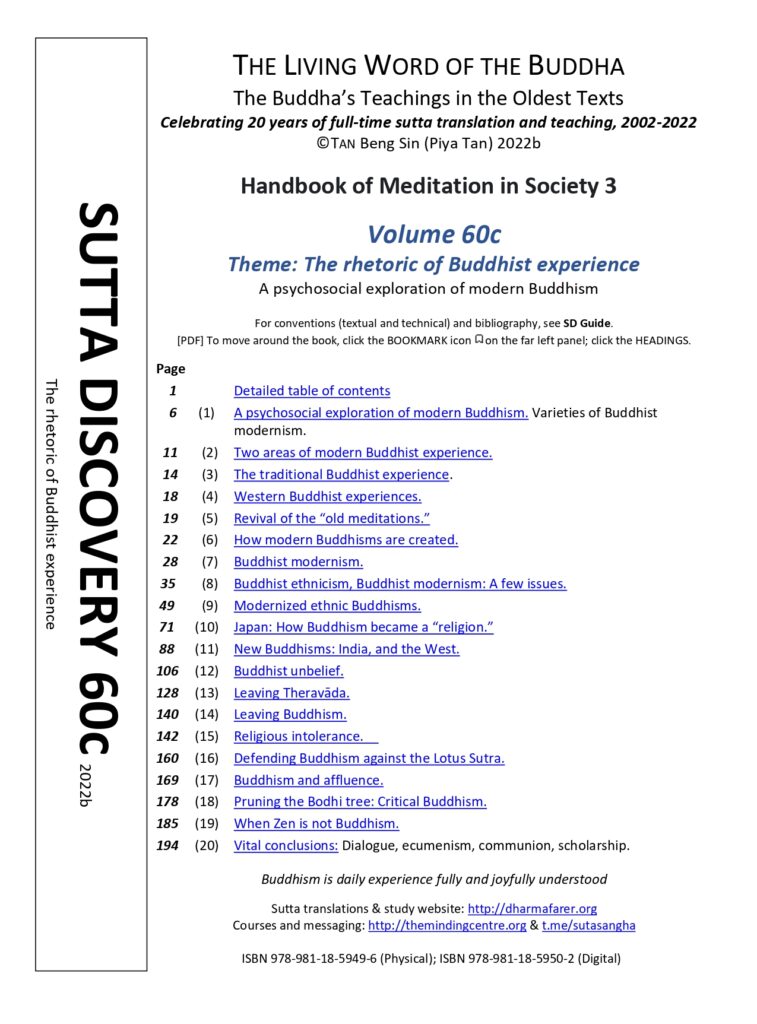
| SD No. | Sutta or Chapter Title | Sutta reference | Theme |
| 60.1c | SD 60.1c Cover, imprint and detailed contents | ||
| 60.1c | A psychosocial exploration of modern Buddhism. | ||
Handbook of Meditation in Society 4 by Piya TanSD 60.1d: An Evolutionary Psychology of Mindfulness: Buddhist experience: the individual and society (2023a).“Mindfulness is knowing ourself so that we awaken to true freedom.” |
|---|
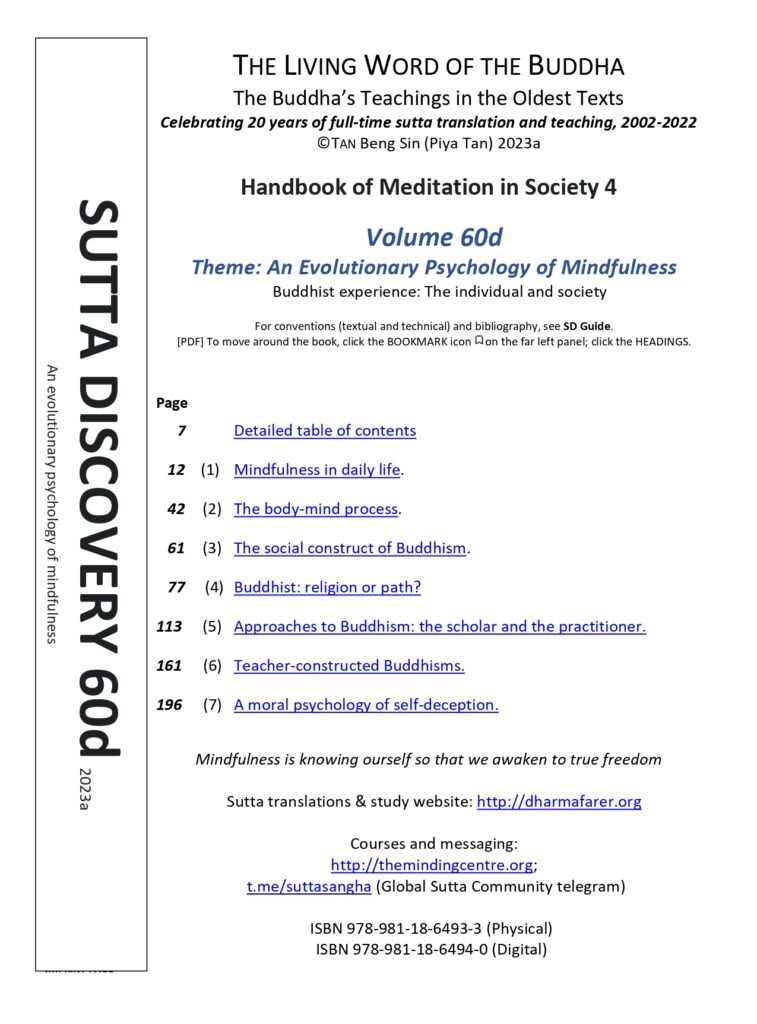
| SD No. | Sutta or Chapter Title | Sutta reference | Theme |
| 60.1d | SD 60.1d Cover, imprint and detailed contents. | ||
| 60.1d | Buddhist experience: the individual and society | ||
Handbook of Meditation in Society 5 by Piya TanSD 60.1e: Delusion and Experience: Epistemology, psychology and the Abhidhamma (2023b).“What we know is what we sense: thinking makes sense of it.” |
|---|
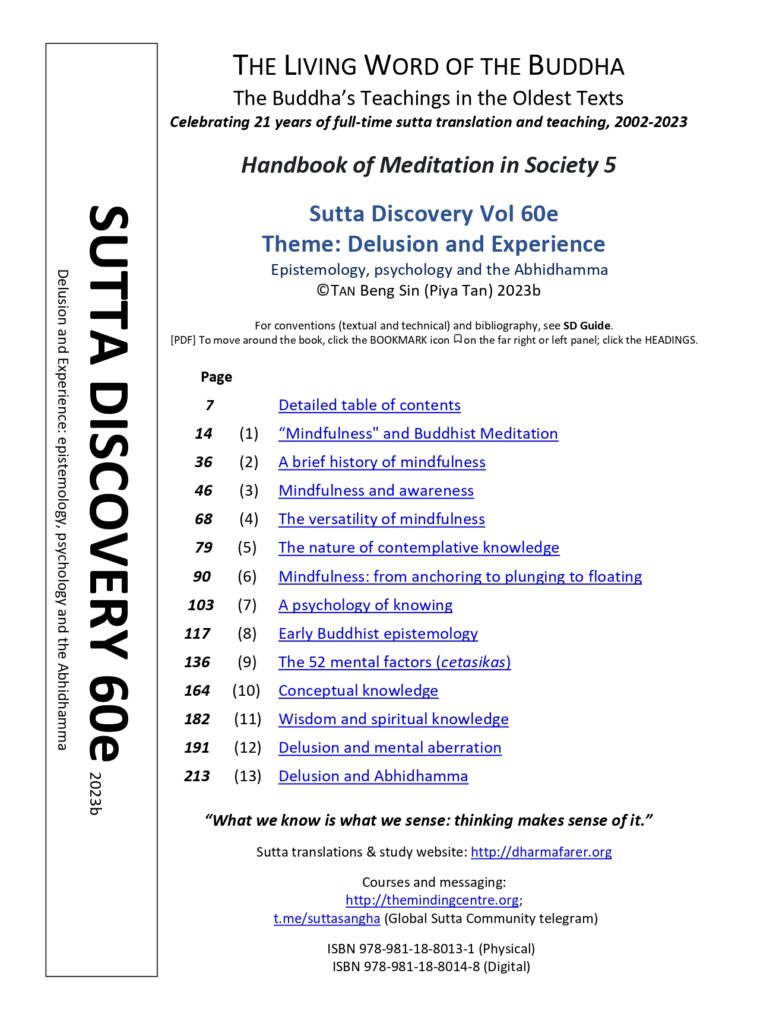
| SD No. | Sutta or Chapter Title | Sutta reference | Theme |
| 60.1e | SD 60.1e Cover and Detailed contents. | ||
| 60.1e | Epistemology, psychology and the Abhidhamma. | ||
Handbook of Meditation in Society 6 by Piya Tan
SD 60.1f: A Psychopathology of Mindfulness: when religion and meditation fail. (2023c).
“Wisdom and science are the better alternative to religion.”
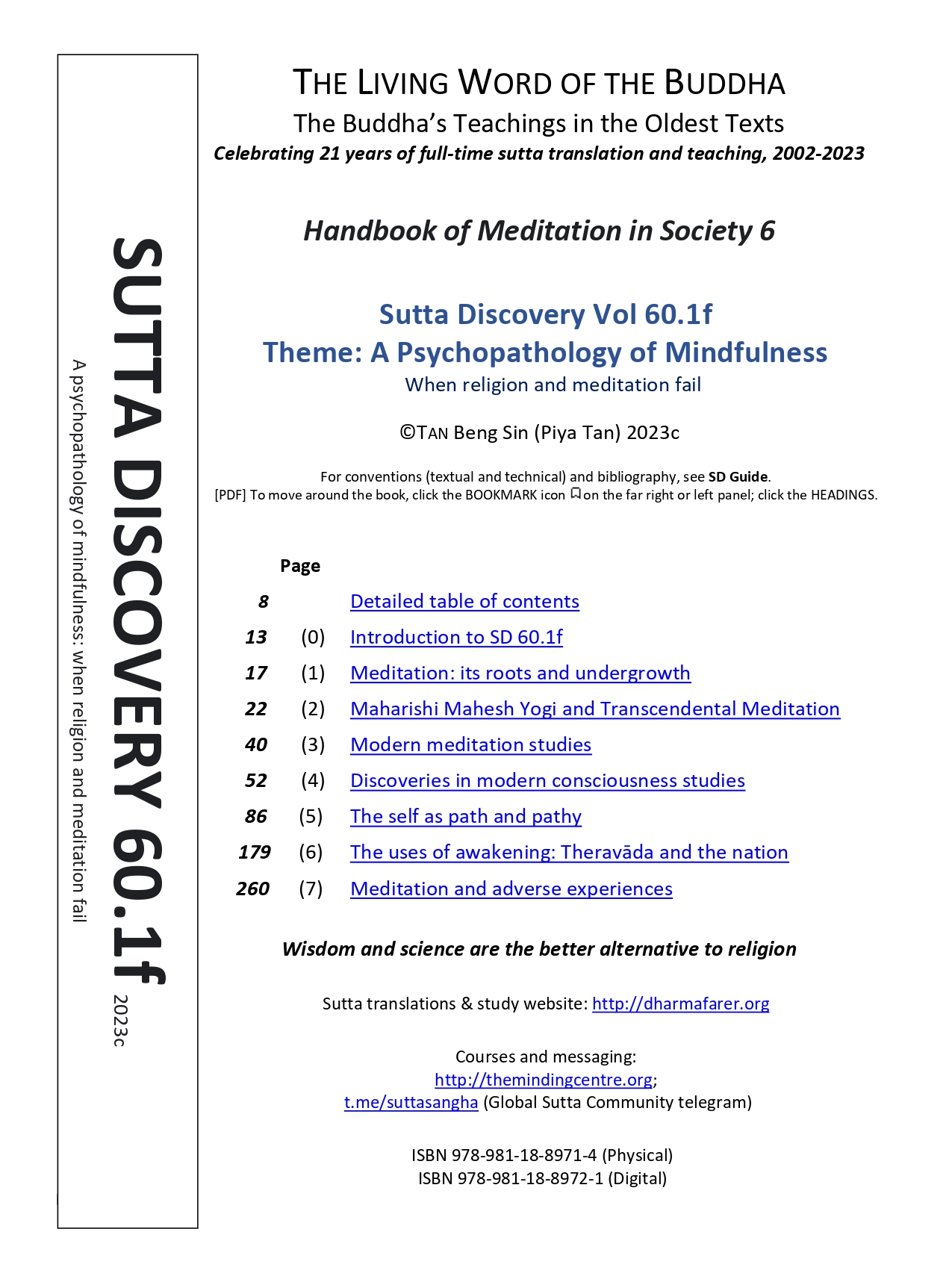 | |||
|---|---|---|---|
| SD No. | Sutta or Chapter Title | Sutta reference | Theme |
| 60.1f | SD 60.1f Cover and Detailed contents. | ||
| 60.1e | When religion and meditation fail. | ||
SD 60.2: Mindfulness in practice. (2024a).“Mindfulness is seeing here, awareness in knowing now.” | |||
|---|---|---|---|
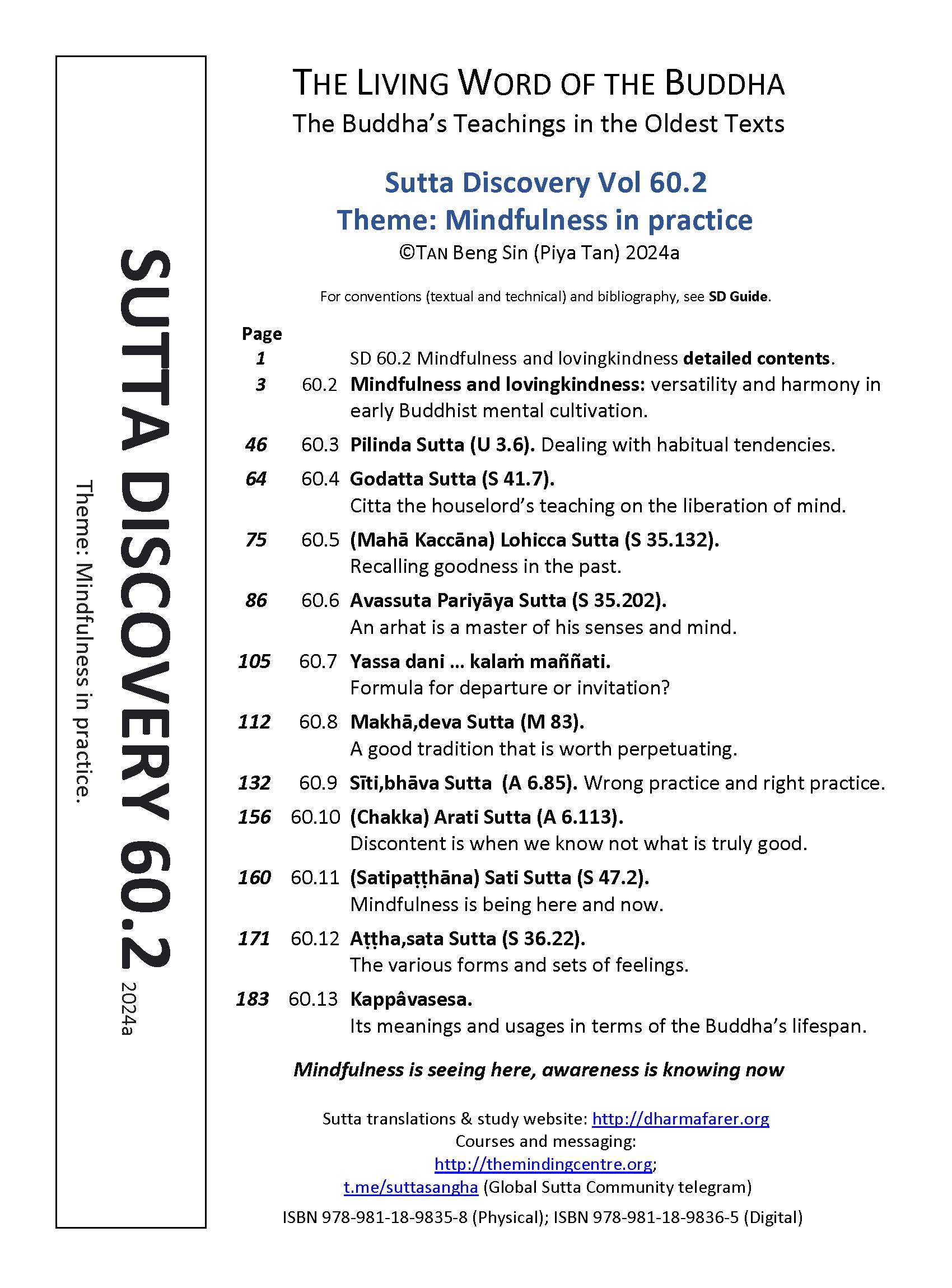 | |||
| SD No. | Sutta or Chapter Title | Sutta reference | Theme |
| SD 60.2 Cover imprint TMC activities | |||
| 60.2 | Mindfulness & lovingkindness | Essay | Versality and harmony in early Buddhist mental cultivation. |
| 60.3 | Pilinda Sutta | U 3.6 | Dealing with habitual tendencies. |
| 60.4 | Go,datta Sutta | S 41.7 | Citta the houselord’s teachings on the liberations of mind. |
| 60.5 | Maha Kaccana Lohicca Sutta | S 35.132 | Recalling goodness in the past. |
| 60.6 | Avassuta Pariyaya Sutta | S 35.202 | An arhat is a master of his senses and mind. |
| 60.7 | Yassadani kalam mannati | Essay | Formula for departure or invitation? |
| 60.8 | Makhadeva Sutta | M 83 | A good tradition that is worth perpetuating. |
60.9 | Sitibhava Sutta | A 6.85 | Wrong practice and right practice. |
| 60.10 | Chakka Arati Sutta | A 6.113 | Discontent is when we know not what is truly good. |
| 60.11 | Satipatthana Sati Sutta | S 47.2 | Mindfulness is being here and now. |
| 60.12 | Atthasata Sutta | S 36.22 | The various forms and sets of feelings. |
60.13 | Kappavasesa | Essay | The meanings and usages of kappavasesa in terms of the Buddha’s lifespan. |
| SD 60.2 BACK COVER 20 reasons for translating suttas | |||
SD 61a: Mara: A Buddhist mythology of evil and the reality of badness. (2024b).“Mara is the dark shadows of the light that let us see.” | |||
|---|---|---|---|
 | |||
| SD No. | Sutta or Chapter Title | Sutta reference | Theme |
| SD 61a | Mara: A Buddhist mythology of evil and the reality of badness. | (Essay) | |
SD 61b: Mara in our daily life. (2024c).“Seek not the light that blinds but one that lets us see.” | |||
|---|---|---|---|
 | |||
| SD No. | Sutta or Chapter Title | Sutta reference | Theme |
| SD 61b Cover imprint TMC activities | |||
| 61.1 | Dvedha Vitakka Sutta | M 19 | Dealing with the duality of thoughts. |
| 61.2 | Nivapa Sutta | M 25 | How to be free from Mara. |
| 61.3 | Cula Gopalaka Sutta | M 34 | Wisely keeping to the gradual way. |
| 61.4 | (Devata) Sakalika Sutta | S 1.38 | The Buddha easily withstands physical pain. |
| 61.5 | Puris’indriya,nana Sutta | A 6.62 | The Buddha’s power of mind-reading. |
| 61.5a | Devadatta | Essay | A study from the Pali texts |
| 61.5b | The Buddha’s Karma | Essay | A study of the Pubba,kamma,piloti and buddhodicy. |
| 61.6 | Sambahula (Bhikkhu) Sutta | S 4.21 | Mara works to hinder renunciation. |
| 61.7 | (Mara) Sakalika Sutta | S 4.13 | The Buddha sleeps happily. |
SD 61c: The various forms of Mara (2024d).“Mara can take on any form, often the one we least expect.” | |||
|---|---|---|---|
 | |||
| SD No. | Sutta or Chapter Title | Sutta reference | Theme |
| SD 61c Cover imprint TMC activities | |||
| 61.8 | Alavaka Sutta | Sn 1.10 | A ferocious cannibal awakens to the teaching of the buddhas. |
| 61.9 | (Mara) Partirupa Sutta | S 4.14 | Mara seeks to fault us when we do good. |
| 61.10 | (Mara) Manaso Sutta | S 4.15 | Mara traps us through the mind. |
| 61.11 | (Mara) Patta Sutta | S 4.16 | We should not be distracted when listening to or studying the Dharma. |
| 61.12 | Cha,phass’ayatana Sutta | S 4.17 | Mara is what distracts us away from doing or being good. |
| 61.13 | (Mara) Pinda Sutta | S 4.18 | Mara deprives the Buddha of food but he lives on joy. |
| 61.14 | (Mara) Sappa Sutta | S 4.6 | Mara appears as a fearsome serpent. |
| 61.15 | Mara Samyutta | S 4.1-25 | The Connected Discourses on Mara. |
| 61.16 | Mara Godhika Sutta | S 4.23 | An arhat’s rebirth-consciousness cannot be found. |
| 61.17 | (Mara) Rajja Sutta | S 4.20 | Mara invites the Buddha to wield sovereignty. |
| 61.18 | Mara in the early Vinaya | Mv 1.11-13. | The first 2 accounts of Mara in the Mahavagga of the Vinaya. |
| 61.19 | (Mara) Pasa Sutta 2 | S 4.5 | The great commission. |
| 61.20 | (Mara) Pasa Sutta 1 | S 4.4 | The second rains: the growing sangha. |
| 61.21 | Devasura Sangama Sutta | A 9.39 | In our battle with Mara we are only safe with a liberated mind. |
| 61.22 | Nandati Suttas | S 1.12 & S 4.8 | The joy of having family and property. |
| 61.23 | (Mara) Ayu Sutta 1 | S 4.9 | Do you want to live long like a suckling baby? |
| 61.24 | (Mara) Ayu Sutta 2 | S 4.10 | Does time fly or turn like a wheel? |
| 61.25 | (Mara) Pasana Sutta | S 4.11 | Mara shatters hill-side boulders on a dark night. |
| 61.26 | (Mara) Kin Nu Siha Sutta | S 4.12 | Are there others who can teach like the Buddha? |
| 61.27 | (Salayatana) Samiddhi Sutta 1-3 | S 35.65 + 66 + 67 | Mara, being and suffering that are the 6 sense-bases. |
| 61.28 | (Mara) Radha Sutta 1 | S 23.1 | The 5 aggregates are Mara. |
| SD 61c BACK COVER 20 reasons for translating suttas | |||
Selected essays from Piya Tan’s SD series (SD 60 onwards) | ||||
|---|---|---|---|---|
| SD No. | Sutta or Chapter Title | Sutta reference | Theme | |
| 64.17 | Bad friendship | Tha 387-392; S 5.35; Dh 33 f; S 6.2.8; D 16.2.26; Dh 160; A 5.88; U 4.1.7. | Avoiding unwholesome teacher-pupil relationship and abuse of religion. | |
| 66.13 | Monastics, sex and marriage |
| ||
| . | ||||
